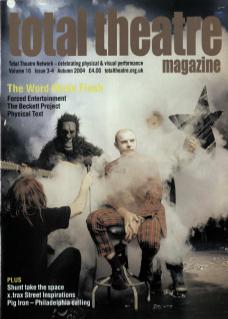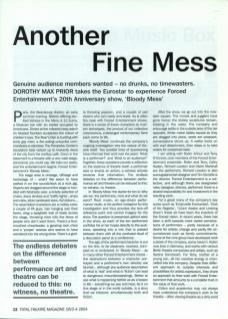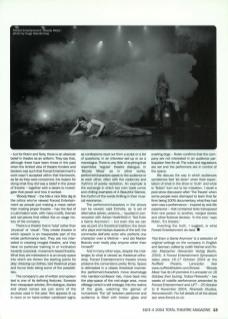Paris, the Beaubourg district, an early summer evening. Bistros offering devilled kidneys in the Menu à 12 Euros, a Mexican bar with tin tables occupied by Americans. Diners at the crêperie keep watch on bloated fountain sculptures the colour of children's toys. The Bear's Den is bursting with burly gay men: a fire-eating unicyclist commandeers a volunteer. The Pompidou Centre's escalators take visitors up to heavenly views of the city from the rooftop café. Down in the basement is a theatre with a very wide stage, panoramic you could say. We take our seats, and the entertainment begins: Forced Entertainment's Bloody Mess.
The stage area is onstage, offstage and backstage of – what? We seem to have walked in on the soundcheck at a rock gig. Objects are dragged around the stage or handled with fetishistic care: a rickety selection of chairs, disco strobes and ‘traffic lights', amps and cabs, silver cardboard stars, foil ribbons... The assembled characters are a motley crew: a couple of PA guys, hair hanging over their faces, drag a spaghetti trail of leads across the stage, thrusting mics into the faces of people who don't want them. There's a foul-mouthed cheerleader, a gyrating rock chick and a ‘proper' actress who seems to have wandered into the wrong show. There's a gorilla throwing popcorn, and a couple of sad clowns who turn nasty and brawl. As is often the case with Forced Entertainment shows, there is a sense of these characters as modern archetypes, the product of our collective unconscious, a deranged contemporary Tarot pack come to life.
Bloody Mess continues the company's ongoing investigation into the nature of theatre itself. Two parallel lines of questioning have informed their work over the years: 'What is a performer?' and 'What is an audience?' Together, these questions provide a reflection on the essence of theatre itself: a performer acts or enacts an action; a witness actively receives that information. The endless debates on the difference between performance art and theatre can be reduced to this: no witness, no theatre.
In Bloody Mess the starter for ten is: Why are we, the performers, here and what do we want? Rock music, an ego-driven performance mode, is the perfect metaphor for this investigation and thus provides the kick-off reference point and central imagery for the show. The question is presented upfront early in the show, as each of the ten performers confides his or her hopes directly to the audience, speaking into a mic that is passed between them with all the confused ritual of a discussion panel at a conference.
The ego of the performer/character is put on the line, to be observed, mocked, trampled on or embraced. In Bloody Mess – as in many other Forced Entertainment shows – the distinctions between a character portrayed and a performer's own identity are blurred... although any audience assumption of what is 'real' and what is ‘fiction' can lead to dangerous misunderstandings. Better to see what is happening before us as a lesson in life – everything we see and hear, be it on this stage or in the world outside, is a story that we interpret, simultaneously truth and fiction.
After the show, we go out into the now-dark square. The mimes and jugglers have gone home; the blobby sculptures remain, bobbing in the water. The company and entourage settle in the outside area of the bar opposite. White metal tables squeal as they are dragged into place, seats are swapped, conversations struck up. A waiter looks on with cool detachment, then steps in to take orders for overpriced beer.
I am sitting with Robin Arthur and Terry O'Connor, core members of the Forced Entertainment ensemble. Robin and Terry, Cathy Naden, Richard Lowdon and Claire Marshall are the performers; Richard Lowdon is also scenographer/set designer and Tim Etchells is the director. Forced Entertainment is a collective, and although there are designated roles (designer, director, performer) there is a shared responsibility for and investment in the resulting work.
For a great many of the company's key works (such as Emanuelle Enchanted, Club of No Regrets, 12am Awake and Looking Down) these six have been the enactors of the Forced vision. In recent years, there has been a shift towards more varied combinations of performers – partly because of a desire for artistic change and partly life circumstances such as family commitments. Some of the core group have developed work outside of the company, some haven't. Robin now lives in Germany, and works with various Berlin theatre companies and artists, such as Gesine Danckwart. For Terry, mother of a young son, all her creative energy is channelled into the company. Despite their different approach to outside interests and possibilities for artistic expression, they share an approach to their work with Forced Entertainment that amounts to a complete trust in the value of that work.
Critics and academics may not always have understood the company's work to be theatre – often viewing theatre as a dirty word – but for Robin and Terry, there is an absolute belief in theatre as an artform. They say that, although there have been times in the past when the limited view of theatre funders and bookers was such that Forced Entertainment's work wasn't accepted within that framework, as far as they were concerned, the reason for doing what they did was a belief in the power of theatre – together with a desire to investigate that power and how it worked.
Bloody Mess – the title a nice little dig at the critics who've viewed Forced Entertainment as people just making a mess rather than making proper theatre – has the feel of a culmination work, with many motifs, themes and set-pieces that reflect the onstage history of the company.
Theirs is a theatre that is ‘total' rather than 'physical' or 'visual'. They create theatre in which speech is an inseparable part of the whole performance text. They are not interested in creating imagist theatre, and they have no particular training in or inclination towards corporeal, movement-based theatre. What they are interested in is an empty space into which are thrown the starting points for play: dressing-up clothes, bad theatrical props and found texts being some of the possibilities.
The company's use of written and spoken text is one of its defining features. Excerpts from newspaper articles, film dialogue, diaries and street names are just some of the sources used in the past. Text appears lit up in neon or on hand-written cardboard signs: as confessions read out from a script or a list of questions; in an interview set-up or as a monologue. There is very little of anything that resembles regular theatre dialogue. In Bloody Mess as in other works, performer/characters speak to the audience or at each other, often with the cadences and rhythms of poetry recitation. An example is the exchange in which two men trade comic and chilling examples of A Beautiful Silence, the rhythm of the words thrilling in their musical resonance.
The performer/characters in the shows can be viewed, said Etchells, as 'a set of alternative selves, versions...' (quoted in conversation with Adrian Heathfield in Not Even a Game Anymore) – but even this we can see as part of a theatrical tradition, the clown who plays and replays aspects of the self, the commedia dell'arte actor who perfects one character over a lifetime – and did Marlon Brando ever really play anyone other than himself?
And in many other ways, despite the challenges to what is viewed as theatrical orthodoxy, Forced Entertainment's theatre shows preserve the conventions pretty firmly. Space is delineated in a classic theatrical manner: the performer/characters move downstage into narrator-confessor role, move back into the play-space of the mid-stage area, move offstage (which is still onstage) into the realms of the gods, watching the games of humankind. The 'pit' between performer and audience is filled with broken glass and snarling dogs – Robin confirms that the company are not interested in an audience participation free-for-all. The rules and regulations are set and the performers are in control of the space.
We discuss the way in which audiences sometimes feel ‘let down' when their expectation of what in the show is ‘truth' and what is "fiction' tum out to be mistaken. I recall a post-show discussion after The Travels when some people were dismayed to learn that far from being 100% documentary, what they had seen was a performance – inspired by real-life experience – that contained texts transposed from one person to another, merged stories and other fictional devices. ‘In the end,' says Robin, 'it's theatre.’
Inventing the truth, I suggest, is what Forced Entertainment do best.
Not Even a Game Anymore is a selection of original writings on the company in English and German, edited by Judith Helmer and Florian Malzacher (Alexander Verlag Berlin, 2004). A Forced Entertainment Symposium takes place 16-17 October 2004 at the Nuffield Theatre, Lancaster. See www.nuffieldtheatre.com/forced. Bloody Mess has its UK premiere in Lancaster on 16 October, then touring. Indoor Fireworks – two weeks of volatile performance presented by Forced Entertainment and LIFT – 25 October to 6 November 2004, Riverside Studios, Hammersmith. For full details of all the above see www.forced.co.uk


